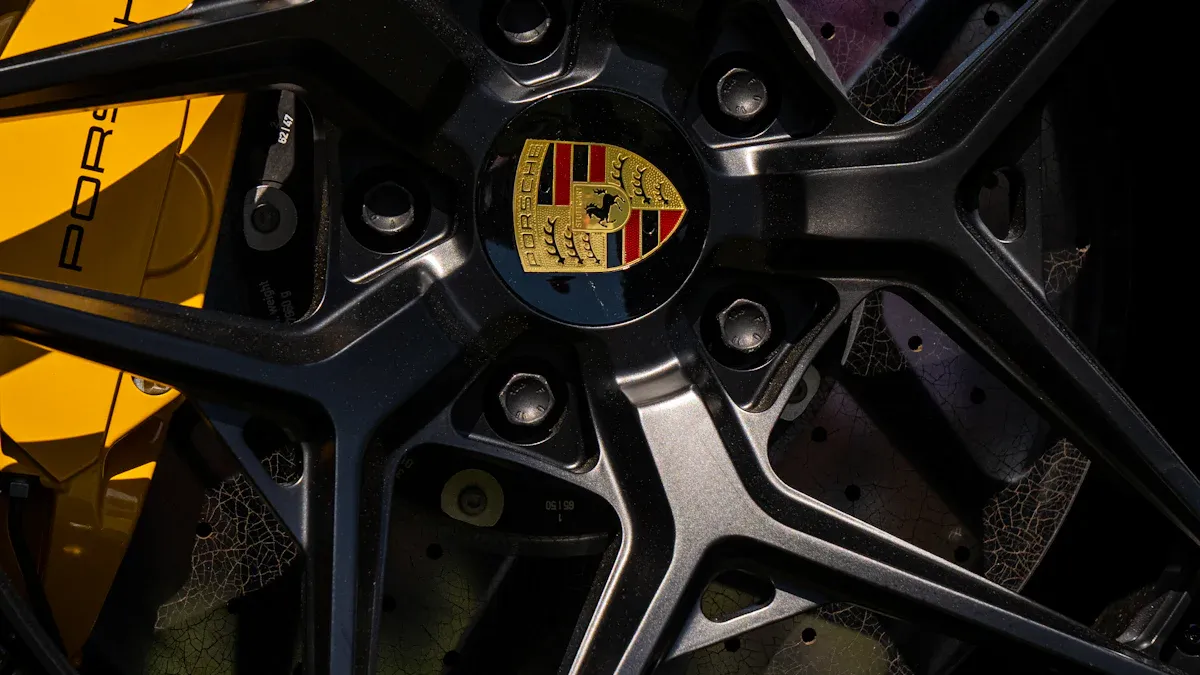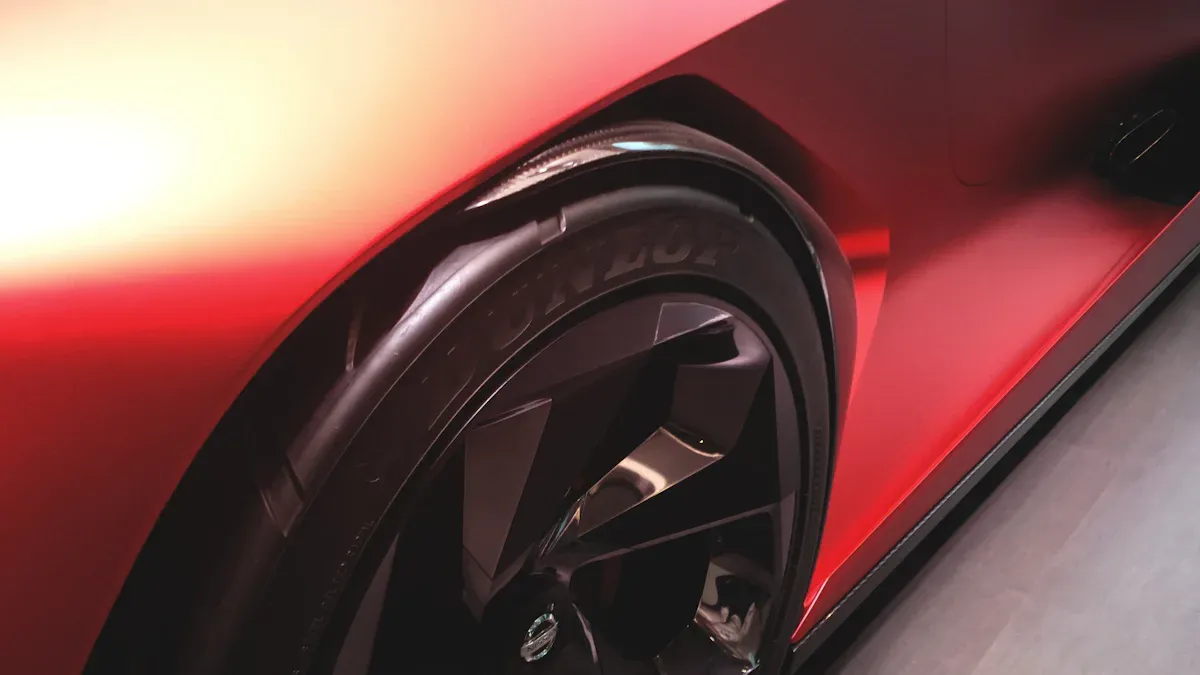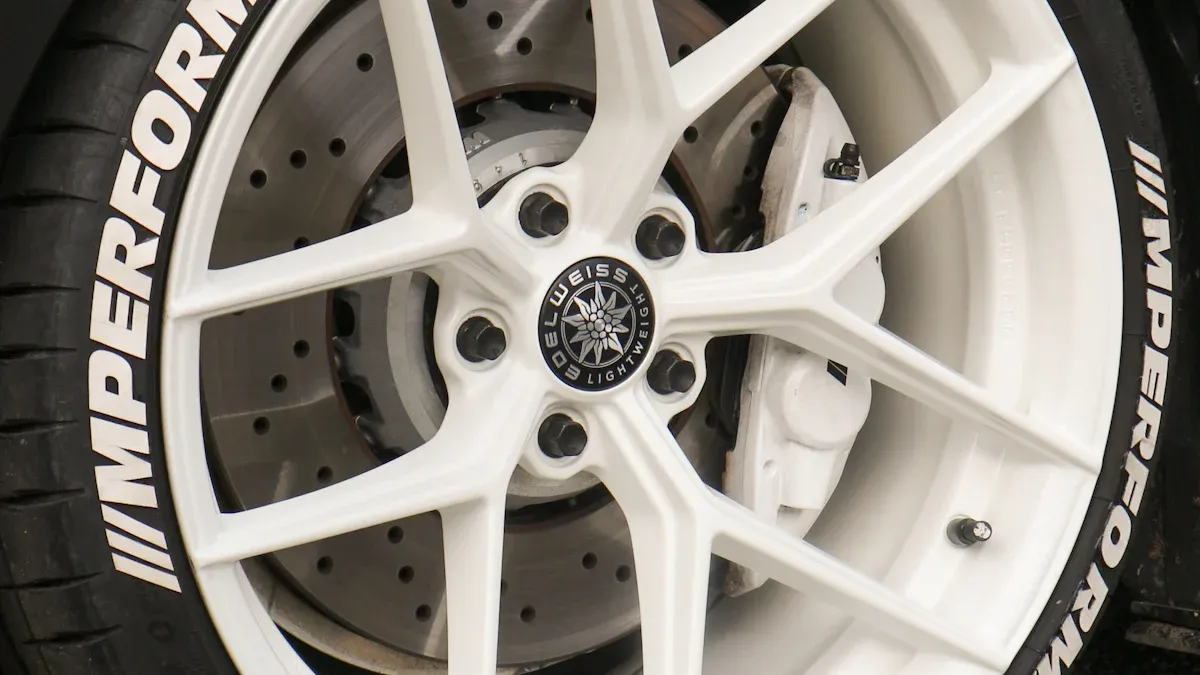

admin1
June 28, 2025
What Are Tire Balance Weights and How They Improve Your Ride

You want your car to give you a smooth and balanced ride. Tire balance weights help you reach that goal by correcting uneven weight on your wheels. When you use a tire balance weight, you make sure each tire rotates evenly. This helps in reducing vibrations that can make your drive noisy or uncomfortable. You also protect your car by improving vehicle performance. Tire balance weights keep your wheels steady, so your tires last longer and your car handles better.
What Is a Tire Balance Weight?

A tire balance weight is a small component that helps your wheels spin smoothly. You use it to fix uneven spots on your tires or rims. When you add a tire balance weight, you make sure your tires rotate evenly. This helps your car drive without shaking or making extra noise. You also protect your tires from wearing out too fast.
Types of Tire Balance Weights
You can find several types of tire balance weights. Each type works best for certain wheels or vehicles. Here are the most common types:
- Clip-on Weights: These attach to the edge of steel or alloy rims. You often see them on older cars and trucks.
- Adhesive (Stick-on) Weights: These have a sticky backing. You press them onto the inside of the wheel. Many modern cars use these because they look neat and do not damage the rim.
- Balancing Beads: These go inside the tire. They move as the tire spins and help keep the wheel balanced. For example, a light truck with a 14-inch rim may need about 4 ounces of balancing beads. Larger vehicles, like buses, may need up to 14 ounces.
Here is a table showing some technical details for a common adhesive tire balance weight:
| Specification | Details |
|---|---|
| Material | Steel coated wheel weight |
| Weight per Segment | 1/2 oz (0.5 ounces) |
| Total Roll Weight | 20 lbs |
| Number of Segments per Roll | 640 segments |
| Segment Dimensions | 3/4 inch (width) x 7-7/8 inch (length) x 3/16 inch (height) |
| Adhesive Backing | Thermally stable up to 356°F, strong hold |
| Weather Resistance | All weather durability |
| Applications | Car, truck, motorcycle, trailer rims |
| Environmental Aspect | More eco-friendly than lead weights |
How Tire Balance Weights Are Attached
You attach tire balance weights in different ways. Clip-on weights snap onto the rim edge. Adhesive weights stick to a clean, dry surface inside the wheel. You must clean the wheel before you attach the weight. This helps the weight stay in place. Many shops use adhesive weights because they do not scratch the rim and look tidy. Some weights use special tape that holds strong in hot or cold weather. You may also find balancing beads that you pour inside the tire before mounting it. Each method follows industry standards to make sure your tire balance stays correct and your ride stays smooth.
Why Tire Balance Is Important
Causes of Imbalance in Tires
You may notice your car does not feel steady on the road. This often happens because of imbalance in your tires. Imbalance means the weight is not spread evenly around the wheel. Even a small difference in weight can cause problems. You might see this after hitting a pothole or curb. Sometimes, new tires or rims have slight differences in weight from the factory. Dirt or debris stuck to the wheel can also create tire imbalance. Over time, normal driving wears down the tread unevenly, which leads to more imbalance.
Tip: Check your tires regularly for signs of uneven wear or damage. This helps you spot imbalance early and keep your ride smooth.
Effects of Imbalance on Ride Quality and Safety
Imbalance in your tires affects how your car feels and how safe it is. When your tires are not balanced, you may feel vibrations in the steering wheel, seat, or floor. These vibrations get worse at higher speeds. You might also notice your car drifts to one side or the steering feels loose. Imbalance causes your tires to wear out faster and unevenly. This can lead to poor traction, making it harder to stop quickly or handle sharp turns.
Here are some common problems caused by tire imbalance:
- Vibrations in the steering wheel, seat, or floorboard
- Uneven or rapid tire tread wear
- Vehicle drifting or pulling to one side
- Driver fatigue from constant shaking
- Reduced traction and less predictable handling
Balanced tires help you avoid these issues. They give you a smoother, quieter ride and help your tires last longer. Regular tire balance checks, every 5,000 to 7,000 miles or once a year, keep your car safe and comfortable. You also protect your suspension and drivetrain from extra strain.
How Tire Balance Weights Solve Imbalance
Tire balance weights fix imbalance by adding the right amount of weight to the wheel. When you visit a shop, a technician uses a special machine to find where the imbalance is. The machine shows exactly how much weight to add and where to place it. The technician attaches the weight to the rim, which cancels out the uneven spots. This process makes sure your wheel spins evenly.
When you use tire balance weights, you reduce vibrations and improve stability. You also prevent early tire and suspension wear. Your car handles better, especially during emergency moves or at high speeds. Balanced tires give you better traction and a more comfortable ride. By keeping your tires balanced, you make your car safer and extend the life of your tires and other parts.
Benefits of Proper Tire Balance
Smoother and Quieter Ride
You notice the difference right away when your tires are balanced. Your car glides over the road with fewer bumps and less noise. Balanced tires help distribute weight evenly, so you feel less vibration in the steering wheel and seat. This makes long drives more comfortable and keeps you alert.
Here is a table that shows how balanced tires improve your ride:
| Benefit | Description | Impact on Driving Experience |
|---|---|---|
| Ride Quality | Dynamic weight distribution | Smoother rides with less vibration on uneven roads |
| Vibration Reduction | Minimizes cabin vibrations | Less driver fatigue and more comfort, with lower noise levels |
| Stability | Improved weight balance | Better control on the road, especially at higher speeds |
Tire balancing beads also help by moving inside the tire as it spins. This action reduces bumps and vibrations, making your ride even smoother and quieter.
Improved Safety and Handling
Proper tire balance gives you more than just comfort. You get better safety and optimal handling. When your tires spin evenly, your car responds faster to steering. You can make sharp turns with confidence. Balanced tires help your vehicle stability, so you stay in control during sudden stops or quick lane changes.
Tip: Regular tire balancing helps you avoid dangerous situations caused by uneven tire wear or poor traction.
Industry standards, like ISO 23671 and ISO 10844, show that balanced tires reduce jolts and vibrations. This means you can trust your car to handle well, even on rough roads.
Longer Tire Life and Better Fuel Efficiency
You save money and time when your tires last longer. Balanced tires wear evenly, so you do not need to replace them as often. You also use less fuel because balanced tires lower rolling resistance. This means your engine does not work as hard to move the car.
- Proper tire balancing reduces vibrations and prevents uneven tire wear, which extends tire life.
- Balanced tires lower rolling resistance, which directly improves fuel efficiency.
- Misaligned or imbalanced tires increase rolling resistance, leading to higher fuel consumption.
- Regular tire maintenance, including balancing and rotation, ensures even tire wear and optimal contact with the road, further enhancing fuel economy.
- Many drivers report better gas mileage after balancing their tires.
A smooth and balanced ride helps you get the most out of every gallon of fuel and every mile from your tires.
Recognizing Imbalance in Your Tires
Common Symptoms of Imbalance
You can spot tire imbalance by paying attention to how your car feels and sounds. When your tires are not balanced, you may notice certain signs of imbalance while driving. These symptoms often appear at higher speeds and can affect your comfort and safety.
- Vibrations in the steering wheel, seat, or floorboard, especially when you drive faster.
- Uneven tire wear, such as cupping or scalloped patterns on the tread.
- Humming, thumping, or roaring noises coming from your tires.
- Steering wheel shaking or feeling off-center.
- Your vehicle pulling to one side.
Scientists use special tools to measure these problems. For example, they check for increased vibration in different directions using sensors. At speeds like 50 to 70 km/h, these vibrations become stronger and easier to detect. You might not see these technical details, but you will feel the effects when driving.
Here is a table showing common diagnostic methods for detecting tire imbalance:
| Diagnostic Method | What It Checks For | What You Might Notice |
|---|---|---|
| Manual Tread Wear Inspection | Uneven or scalloped tread patterns | Bumpy ride, odd tire wear |
| Dynamic Balance Machine | Small weight differences in the tire/wheel | Accurate detection, smooth ride |
| Tire Problem Detector | Vibration and movement at low speeds | Shaking or bouncing at slow speeds |
| Radial Runout Measurement | Out-of-round tires or wheels | Thumping noise, uneven wear |
Tip: Regular maintenance helps you catch these symptoms early and keeps your ride safe.
When to Seek Tire Balancing
You should schedule tire balancing as part of your regular maintenance routine. Most experts recommend balancing your tires every 6,000 to 8,000 miles or every six months. If you drive on rough roads or use low-profile tires, you may need to balance them more often.
Look for these situations as clear signals to get your tires checked:
- You feel vibrations in the steering wheel, seat, or floor.
- You notice uneven tire wear, especially cupping or scalloping.
- You hear humming or thumping noises from your tires.
- You have installed new tires or repaired a tire.
- A wheel weight has fallen off.
- You have not balanced your tires in a long time.
- You recently rotated your tires or had suspension repairs.
Regular tire balancing prevents early tire wear and improves your car’s performance. Good maintenance also helps you save money by extending tire life and boosting fuel efficiency. Paying attention to these signs of imbalance keeps your vehicle safe and comfortable on the road.
The Tire Balance Process: Professional vs. DIY

How Professionals Balance Tires
When you visit a professional shop for tire balancing, you get precise results. Technicians use computerized spin balancing machines. These machines find even the smallest imbalance, sometimes as little as 0.1 ounces. The technician places your wheel on the machine, which spins it at high speed. The machine shows exactly where to add weights for perfect balance.
Professionals also check your tires for damage, bulges, or uneven wear before starting. They use calibrated equipment that gets tested often. This process helps you avoid mistakes and keeps your ride smooth. You also lower the risk of early tire wear and save money on repairs. Most shops charge $15 to $45 per tire, which can be more cost-effective than buying your own equipment.
Here is a table comparing different balancing methods:
| Method | Accuracy and Success Rate | Pros | Cons |
|---|---|---|---|
| Professional Spin Balancing | High accuracy; finds small heavy spots | Extends tire life; best for passenger vehicles | Needs periodic rebalancing; can be costly |
| DIY Static Balancing | Reasonable balance; misses dynamic imbalance | Affordable; simple to use | Less precise; not for high-performance use |
| Tire Balancing Beads | About 75% success in lighter vehicles | Self-adjusting; eco-friendly; lasts tire’s life | Lower success in light vehicles; dosing key |
DIY Tire Balancing: What to Know
You can try balancing your tires at home, but you need to know the risks. DIY static balancing kits cost about $60 to $75. These kits help you find basic imbalances, but they do not fix dynamic issues like side-to-side wobble. You may miss small problems that only show up at higher speeds.
Common mistakes include using uncalibrated tools, placing weights in the wrong spot, or ignoring tire defects. These errors can lead to vibrations, uneven tire wear, and even damage to your suspension. You also face hidden costs if you make mistakes, since 80% of tire problems come from imbalance. Professional balancing extends tire life by up to 20% and improves fuel economy.
Here are some key points to remember:
- DIY balancing works for simple maintenance, but it cannot match professional accuracy.
- Static balancing does not fix all types of imbalance.
- You must check your tools and follow safety steps to avoid injury.
- Regular maintenance by professionals gives you better results and keeps your car safe.
If you want the best ride and longer tire life, schedule professional balancing as part of your regular maintenance routine.
“Well-balanced tires mean a smoother ride, improved fuel efficiency, and safer travels. Regular tire balancing is essential not only for extending tire life but also for ensuring your safety and vehicle reliability.”
You can protect your tires and enjoy a better drive by checking your tire balance often. Here are key reasons to keep your tires balanced: 1. Extend tire lifespan by preventing uneven wear. 2. Enhance safety by reducing vibrations and improving control. 3. Improve driving comfort with a smoother ride. 4. Increase fuel efficiency by lowering engine strain.
Trust experienced professionals like Fortune to balance your wheels with care and precision.
FAQ
How often should you balance your tires?
You should balance your tires every 6,000 to 8,000 miles. If you notice vibrations or uneven tire wear, get them checked sooner. Regular balancing keeps your ride smooth and helps your tires last longer.
Can you drive with missing or loose wheel weights?
You should not drive with missing or loose wheel weights. Your car may shake or pull to one side. This can cause uneven tire wear and reduce safety. Visit a professional to fix the problem right away.
Do all vehicles need tire balance weights?
Yes, all vehicles need tire balance weights. Cars, trucks, motorcycles, and trailers all benefit from balanced wheels. Proper balance improves safety, comfort, and tire life for every type of vehicle.
What happens if you skip tire balancing?
If you skip tire balancing, you may feel vibrations in your steering wheel or seat. Your tires can wear out faster. You might also use more fuel. Regular balancing helps you avoid these problems.
Are adhesive or clip-on weights better?
Both types work well. Adhesive weights stick inside the rim and look neat. Clip-on weights attach to the rim edge and suit some wheels better. Your technician will choose the best type for your vehicle.





